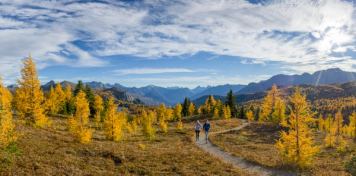Fall in the Canadian Rockies ushers in a vibrant palette of yellow, orange and red that illuminates the alpine landscape. But among the blanket of common pine trees is something truly special. The larch trees, which are unassuming for most of the year, transform into a striking shade of gold as fall begins.
But the larch trees only put on their brilliant display for a fleeting time. Your best chance to see them in full force is between mid-September and early October, but this is weather-dependent.
Keep reading to learn more about larches and what makes these elusive trees special.
What are larches and why are they special?
Larches may look like other varieties of conifers — needle-producing trees like fir, spruce and pine — but they have one distinct difference. Larch trees come from a group of related families known as Larix, and they are deciduous. This means they lose their foliage come winter. There are around 10 larch species present in North America (three of which are native), including tamaracks (Larix laricina) and Lyall’s Larch (Larix lyallii) — the famous golden variety found in the Canadian Rockies.
“In Canada, larches are really the only conifer we have that have that feature,” says Francoise Cardou, an assistant professor in the Faculty of Science at the University of Calgary. “That’s what makes them stand out in the Canadian flora.”
Why larches turn yellow
But what creates their distinctive golden hue? The transformation is part of a process called senescence, which is what happens to all deciduous trees when they lose their leaves each year. Losing foliage helps mitigate nutrient loss, explains Cardou, who specializes in plant ecology.
“Trees can keep their foliage for many years, which is what most evergreens do, and it means they invest a lot of resources in those needles,” she adds. “They make sure they’re very hardy and they can withstand the winter and damage from insects. These are going to be tough leaves if they stay for multiple years.”
Since larches don’t invest nutrients into their foliage as the seasons change, there’s no benefit in hanging onto it throughout the winter. They start reabsorbing the nutrients, which causes the needles to change colour.
“They have a cocktail of pigments in the leaf tissue and chlorophyll, the green one, will tend to degrade first. The nutrients contained in there are reabsorbed into the plants,” Cardou says. “When the chlorophyll is gone the others remain, so what you see is the colour of the other remaining pigments."
The pigments have nutrients in them, Cardou explains, and they’re big, complicated molecules that can essentially be broken down for parts. The specific colour a species changes into will depend on the cocktail of pigments it has, along with specific physiology and environmental factors like water stress and heat.
“It’s a complicated physiological process that remains somewhat mysterious,” she notes.







